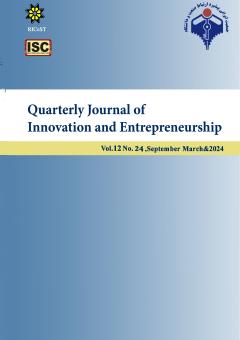Presenting a Small Buisiness Model in Cyberspace with an Entrepreneurial Approch
Subject Areas : Promoting and developing entrepreneurial culture
hamed bahadorian
1
![]() ,
serajaldin mohebi
2
*
,
serajaldin mohebi
2
*
![]() ,
hosein mansoori
3
,
hosein mansoori
3
![]()
1 - Department of Public Management and Human Resources, Qeshm Branch, Islamic Azad University, Qeshm, Iran
2 - Department of Management, Islamic Azad University, Shiraz Branch, Shiraz, Iran
3 - Department of Industrial and Government Management, School of Management and Accounting, Hormozgan University, Bandar Abbas, Iran
Keywords: Entrepreneurial Approach, Model, Small Business, Virtual Space,
Abstract :
The purpose of this research is to present the small business model in cyberspace with an entrepreneurial approach. In terms of practical purpose, the research is survey-descriptive; in terms of data collection, the research approach is inductive reasoning and exploratory mixed research strategy in which qualitative research is used in the first stage and quantitative research in the second stage. The method of collecting information in the qualitative part was in-depth interviews. For this purpose, theoretical sampling was done from the research community, which includes experts and managers in the field of business in virtual space and professors in the field of software (business). In this way, with thirty people interviews have been conducted. In the quantitative part of the research, data were collected using a questionnaire. The sampling method was stratified random in a proportional way. To determine the sample size in a limited population, 77 people were selected by using Cochran's method. In the qualitative part (grounded theory), data analysis was used on the basic theory and the coding process. In the quantitative part of the research, after collecting and summarizing the data, descriptive tests, exploratory factor analysis and exploratory structural equation modeling were used using SPSS 24 and PLS Smart 2 software. The findings showed that knowing human relations, investing in entrepreneurship, keeping up with the fast-paced changes in the world, requirements of virtual business, knowing the characteristics of the market and characteristics of the buyer, are the effective factors on the small business model in the virtual space with an entrepreneurial approach
منابع 1. اسماعیل¬پور و جعفرپور(1393). نقش و کاربردهای تجارت الکترونیک در فعالیتهای بازاریابی. بانک مقالات بازاریابی. 2. حقی, سعید، وهابی، عباس و اسفندیار فرج¬زاده (۱۳۹۶). تأثیر تجارت الکترونیک بر روی عملکرد مالی بانک قرض¬الحسنه رسالت، بررسی نقش واسطه¬ای نو آوری سازمانی. اولین کنفرانس ملی نقش حسابداری، اقتصاد و مدیریت، تبریز، موسسه آموزش عالی علم و فن آوری شمس. 3. جهاندیده، محسن (1391). بررسی عوامل موثر بر تأثیر تجارت الکترونیکی در صنایع کوچک و متوسط فعال در صنعت شیلاتی چابهار و کنارک. پایان نامه کارشناسی¬ارشد، دانشگاه سیستان و بلوچستان. 4. چهار سوقی، سیدکمال، سجادی¬نژاد، آرمان، بیک¬زاده، نسرین (1392). تجزیه وتحلیل شاخصهای اساسی عملکرد در تجارت الکترونیکی با استفاده از ارزیابی عملکرد متوازن: موردکاوی سایتهای تجاری ایران. پایاننامه کارشناسی ارشد، دانشگاه تربیت مدرس، دانشکده فنی و مهندسی . 5. رضایی، بیژن و نعمان موسی، سبا(1395). کارآفرینی در بستر فناوری اطلاعات و ارتباطات، کنفرانس بینالمللی کسبوکار: فرصتها و چالشها. 6. رئیسی نافچی، سمانه(1396). مروری بر مدلهای کسبوکار الکترونیک: بررسی عوامل مؤثر بر پیادهسازی مدل کسبوکار الکترونیک در SMEها. سومین کنفرانس بینالمللی کارآفرینی، خلاقیت و نوآوری، تهران. 7. مرادی علمدارلو, وحید و سعید سعیدااردکانی (۱۳۹۶). تأثیر رضایت از خرید آنلاین بر وفاداری مشتری با توجه به نقش جذابیتهای جایگزین (مورد مطالعه: مشتریان دیجی کالا). سومین کنفرانس بین¬المللی مدیریت و مهندسی صنایع، تهران، دانشگاه مقدس اردبیلی. 8. موحدي، مسعود (1383). موانع فرهنگي استقرار تجارت الکترونيکي در ايران. چاپ مرکز ملي شماره¬گذاري کالا و خدمات، به نقل از اشنايدر و بارسو. 9. میررحیمی، الناز (1390). بررسی عوامل موثر در جلب اعتماد مشتری در تجارت اینترنتی که در موسسه آموزش عالی غیر دولتی غیر انتفاعی کار. پایان¬نامه کارشناسی ارشد، موسسه آموزش عالی غیر دولتی غیر انتفاعی کار. 10. Abdolmohammadi, M. J., DeSimone, S. M., Hsieh, T. S., & Wang, Z. (2017). Factors associated with internal audit function involvement with XBRL implementation in public companies: An international study. International Journal of Accounting Information Systems, 25, 45-56. 11. Analyzing e-business value creation from a resource-based perspective. International Journal of information management, 28(1), 49-60. 12. Beauchamp, M. B., & Ponder, N. (2010). Perceptions of retail convenience for in-store and online shoppers. The Marketing Management Journal, 20(1), 49-65.
13.Chrisman, James (2006). Entrepreneurship. In Michael Hitt & Duane Ireland, Entrepreneurship,Victoria: Blackwell Publishing, pp. 120 - 122.
14. Duarte, P., e Silva, S. C., & Ferreira, M. B. (2018). How convenient is it? Delivering online shopping convenience to enhance customer satisfaction and encourage e-WOM. Journal of Retailing and Consumer Services, 44, 161-169.
15. Gu, V. C., Cao, Q., & Duan, W. (2012). Unified Modeling Language (UML) IT adoption—A holistic model of organizational capabilities perspective. Decision Support Systems, 54(1), 257-269.
16. Jardim-Goncalves, R., Popplewell, K., & Grilo, A. (2012). Sustainable interoperability: The future of Internet based industrial enterprises. Computers in Industry, 63(8), 731-738.
17. Johannessen, K. A., Kittelsen, S. A., & Hagen, T. P. (2017). Assessing physician productivity following Norwegian hospital reform: A panel and data envelopment analysis. Social Science & Medicine, 175, 117-126.
18. Kwak, J., Zhang, Y., & Yu, J. (2019). Legitimacy building and e-commerce platform development in China: The experience of Alibaba. Technological Forecasting and Social Change, 139, 115-124.
19. Lynn Martin and Tamara McNeill, Izzy Warren-Smith, 2013, Exploring business growth and eco innovation in rural small firms, International Journal of Entrepreneurial Behavior & Research, 19(6): 592 – 610.
20. Popa, S., Soto-Acosta, P., & Perez-Gonzalez, D. (2018). An investigation of the effect of electronic business on financial performance of Spanish manufacturing SMEs. Technological Forecasting and Social Change, 136, 355-362.
21. Teixeira, M.L.P.a.A.A.C. Twenty Years of Rural Entrepreneurship, (2016). A Bibliometric Survey،56: 12-22.
22. Tumbas, S., Berente, N., and Brocke, J.V. (2018). Digital innovation and institutional entrepreneurship:Chief Digital Officer perspectives of their emerging role,Journal or information Technology, 1-37.
23. Zhu, Z., & Lin, S. F. (2019). Understanding entrepreneurial perceptions in the pursuit of emerging e-business opportunities: The dimensions and drivers. Computers in Human Behavior, 95, 252-261.
Soto-Acosta, P., & Meroño-Cerdan, A. L. (2008).

